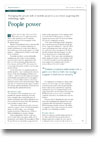
People power
- Article 1 of 1
- Enterprise Mobility, September 2004
Managing the people side of mobile projects is as critical as getting the technology right.
Page 1 | Page 2 | All 2 Pages
The roll-outs of WiFi, GPRS, Bluetooth, VPNs and (soon) 3G applications have shown that wireless access to corporate networks and data is becoming part of the IT infrastructure.
But the IT department has to contend with more than just the technical challenges of mobile enablement. It is also being asked to deal with many of the people aspects of mobile projects – with pressures evident at both ends of the workforce.
From the top down, senior and middle management now expect secure roaming access to their email, key applications and files. As well as wanting wired connection from laptops and home PCs, this group has increasingly demanded mobile access through pocket devices.
At the same time, the implementation of mobile projects – say, to automate the data collection work and scheduling of field service workers – often sees the IT department tasked with introducing mobile devices and applications to sections of the workforce who have had little contact with such technologies. They may also be worried about the impact on their job security and the possibility of such devices monitoring their physical location.
Jumping the gun
The demands of the management are compounded by another dimension. In many cases, managers have jumped the gun on mobile technology and tried to plug their own devices into the network before the infrastructure is ready to support them.
That raises unwelcome security concerns, and often requires a level of enforced standardisation on device type – even when that requires loyal fans of Blackberrys, iPAQs or Nokia smartphones to accept a change.
Some organisations choose to ban any devices other than those approved by the IT department, says Ashim Pal, an analyst at Meta Group. But he recommends an approach that balances the enthusiasm of the employee with the need of the IT department to be able to support any devices used for work and ensure they do not compromise security.
“If it’s a line-of-business device integrated into a specific process, IT should provide the device, support it and fund it,” says Pal. “If it’s more a personal productivity tool with calendar, mail and contact management, IT should provide software and some support, but the device should be down to the individual.”
He adds: “If the user wants something else and is prepared to fund it, they should be able to. You have to make it clear though that you won’t support the hardware and it will be down to them to fix it if it breaks.”
In comparison to attempts to bring consistence to the device type, the task of making network access secure looks less problematic. Secure email access is possible by requiring email protocols to be encrypted using secure socket layer (SSL) and virtual private networks (VPNs) provide a secure way to extend the corporate network to the mobile user over the Internet.
Page 1 | Page 2 | All 2 Pages
